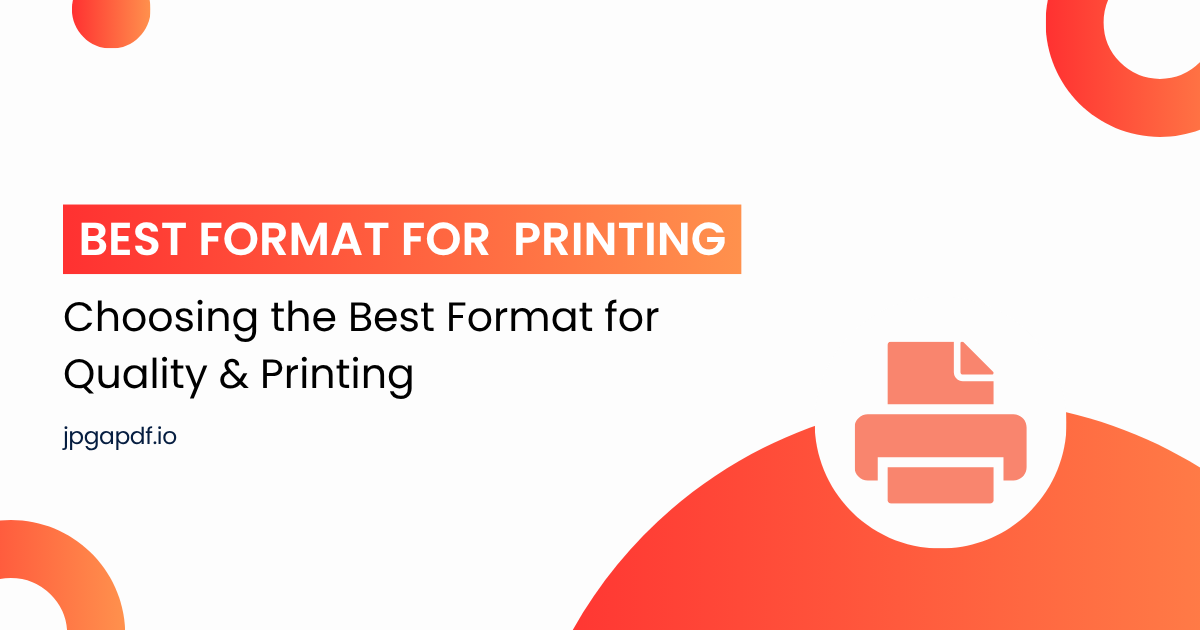
JPG vs PNG: Which One Is the Best Format for Quality & Printing
Do you want to know which format is best for printing? No doubt, image format affects the final print quality, so choosing the right one is essential. JPG and PNG come with different qualities, and that’s why each one suits a different purpose. Some formats highlight sharp lines and background clarity, while others focus on reducing file size for easier storage or faster use.
So, you need to know about these formats, when JPG is enough, and when PNG gives a better result. This blog will help you understand how both formats perform, where each one fits, and which one handles printing tasks more effectively.
What Is JPG?
JPG is the short form of Joint Photographic Experts Group. It suits full-color photos because it uses lossy compression. It means it removes some data to shrink the file size. As a result, you get faster load times and save storage space, especially when you're dealing with websites or mobile use.
Additionally, JPG helps you store large photo files in a smaller space, but every time you save it again, the quality drops slightly.
Key Features of JPG:
Lossy Compression: Cuts file size by removing some image data, which reduces clarity after multiple saves.
Small File Size: Useful for web uploads and faster sharing.
No Transparency Support: Doesn’t support clear backgrounds, so not useful for overlays or layered designs.
Great for Photos: Ideal for full-color images with gradients.
Decent for Casual Prints: Works well for photos but loses fine details in high-precision prints.
What Is PNG?
PNG is the abbreviation of Portable Network Graphics. It uses lossless compression, so no detail is lost after saving. It means PNG keeps your lines sharper and your visuals cleaner. You can depend on it when the design calls for high accuracy.
It also supports transparent backgrounds, which helps when you place one image over another. Unlike JPG, PNG holds up even when your design includes small icons or text. That’s why most designers choose PNG when quality matters most.
Key Features of PNG
Lossless Compression: Keeps full image detail, which helps with print clarity.
Supports Transparency: Useful for logos and graphics that need clean backgrounds.
High Print Precision: Handles small elements, lines, and text clearly.
Larger File Size: Uses more space compared to JPG.
Used for Pro Prints: Works well for business cards, brochures, posters, and brand materials.
Which Format Handles Quality Better?
JPG delivers soft gradients and natural colors, so it works well for portraits, scenic views, or travel shots. You get smooth skies and warm skin tones without harsh edges. But once you zoom in, fine details start to fade. It happens because JPG compresses the file by removing some data, which slightly lowers the clarity.
Use JPG when:
You’re printing photo-based designs without needing sharp edges
File size matters more than flawless precision
You’re working on family prints or simple posters
You want faster loading or saving
PNG gives you a perfect result every time you open or save it. The image stays sharp and every line looks exactly right. It also handles transparent areas without leaving ugly outlines. You can rely on PNG when quality can’t be compromised.
Use PNG when:
You need a clear background in icons or logos
The design includes small text or intricate elements
You're working on brand materials or pro-level prints
The project includes outlines or layered visuals
Which format delivers better quality in printing?
Printing demands rich colors and smooth transitions, so JPG fits well in that case. It suits designs without sharp outlines or layered elements. But when your file has logos or text, JPG loses clarity around the edges.
PNG gives better results when precision matters. It keeps lines sharp without adding fuzzy borders or pixel distortion. You can trust it for prints that need accuracy in every detail. That’s why the final output looks sharp and professional.
Conclusion
The right Image format plays an important role in printing. So, you need to understand the right use of these formats. It is only possible when you know their characteristic. JPG fits when storage space is limited and the print doesn’t need high precision, while PNG delivers better results when your project demands sharp quality and fine detail.
In short, every format has its strengths, so pick the one that fits your goal. Your choice shapes the result, and your prints will turn out just the way you expect.
FAQs
Can I print high-quality images from a JPG?
Yes. JPG works for photos and casual prints. But when you're working on sharp details or text, PNG gives better results.
Why do PNG files look clearer than JPGs?
PNG doesn’t remove image data. That’s why it stays sharp. JPG deletes some data to shrink the size, which affects clarity.
Which format supports transparent backgrounds?
Only PNG supports transparent backgrounds. On the other hand, JPG always comes with a solid one.
Can I convert a JPG to another format without losing quality?
You can convert the JPG to PDF or PNG, but the original JPG quality stays the same. Converting won’t fix earlier compression losses.
When should I use the JPG format for printing?
If you're printing large photos without much detail, choose the JPG format, and when you need more clarity, select PNG.
Is PNG best for digital and print?
Yes. PNG supports both. It looks sharp on screens and stays perfect in print, especially when every detail counts.